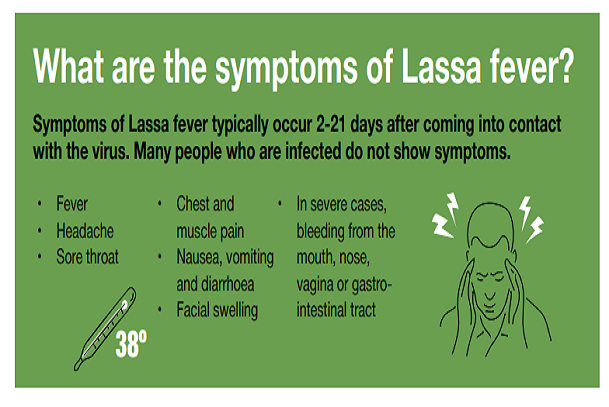 Wash your hands regularly and wear a face mask.
Learn more
Wash your hands regularly and wear a face mask.
Learn more

How Does Lassa Fever Present Itself?
Lassa fever is a viral illness that occurs in West African countries like Nigeria. It is caused by the Lassa virus in a rodent of the genus Mastomys known as a “multimammate rat”. The Lassa virus is transmitted to humans mainly through food or household items contaminated by infected rats’ urine and faeces and by handling infected rats.
Lassa fever usually begins with a flu-like illness and other symptoms such as:
Hemorrhage is not common in less serious diseases, but the loss of fluid from blood vessels into tissue may occur; this causes facial swelling, reddened whites of the eyes, and fluid around the lungs and heart, but bleeding from the mucus membrane occurs in severe illness.
In around 1 percent of all cases, Lassa fever is fatal, and around 15 to 20 percent of all hospitalizations for the disease will end in death. Death can occur within 2 weeks after the onset of symptoms due to multiple organ failure.
One of the most common complications of Lassa fever is hearing loss, which occurs in around 1 in 3 infections. This hearing loss varies in degree and is not necessarily related to the severity of the symptoms. Deafness caused by Lassa fever can be permanent and total.
Finally, it is particularly dangerous for women in their third trimester of pregnancy. Spontaneous loss of pregnancy occurs in around 95 percent of pregnancies.
Investigation of Lassa Fever
According to the World Health Organization (WHO), the symptoms of Lassa fever are so varied and non-specific, that clinically diagnosing Lassa fever early can often be difficult because it may be difficult to distinguish it from other viral haemorrhagic fevers such as Ebola virus diseases, as well as other diseases that cause fever, malaise, typhoid fever, and yellow fever.
Definitive diagnosis requires testing that is available only in reference laboratories. Laboratory specimens may be hazardous and must be handled with extreme care. Lassa virus infections can only be diagnosed definitively in the laboratory using the following tests:
This is why Lassa fever should be suspected in individuals in Nigeria especially endemic areas that have been identified who show typical symptoms. And such cases should be reported to the nearest medical centers in charge of the Lassa fever virus (centers such as the Federal Medical Centre, Owo, Ondo State; Irrua Specialist Teaching Hospital, Irrua, Edo State; and Lagos University Teaching Hospital, Idi-Araba, Lagos).
How Can Lassa Fever Be Managed?
Treatment of Lassa Fever
There is no vaccine available against Lassa fever. The antiviral drug Ribavirin seems to be an effective treatment for Lassa fever if given early on in the course of clinical illness. There is no evidence to support the role of Ribavirin as post-exposure prophylactic treatment for Lassa fever.
Oral Ribavirin given as prophylaxis or preventive treatment has been studied in a limited fashion during an outbreak, with no evidence of transmission; however, only 40% of the small number of participants completed treatment due to side effects from Ribavirin that included weakness, dizziness, headache, and nausea.
In light of the severe 2018 outbreak in Nigeria, the World Health Organization and several global public health entities are working tirelessly to develop an effective vaccine.
Managing Lassa Fever Cases
In managing Lassa fever, there are suspected, probable, and confirmed cases, with each category being managed differently.
In suspected cases:
In probable cases:
In Confirmed Cases:
This leads to being quarantined in a special section of the hospital. And at hospitals where Lassa fever is practicable, all cases (suspected, probable, and confirmed cases) are further separated into ‘wet’ and ‘dry’ categories. Wet includes bleeding, vomiting, diarrhea, coughing, and sneezing; while ‘dry’ includes patients without wet symptoms
For a suspected case who has established contact with a confirmed case, the commencement of Ribavirin should be immediate while lab results OR if clinical features strongly support the diagnosis of Lassa fever.
Who is a contact? A contact is a person who has been exposed to an infected person or an infected person’s secretions, excretions, or tissues within three weeks of last contact with a confirmed or probable case of Lassa fever.
It is the public health responsibility to:
Prevention of Lassa Fever
Prevention of Lassa fever relies on promoting good community hygiene to discourage rodents from entering homes. This can be possible by: